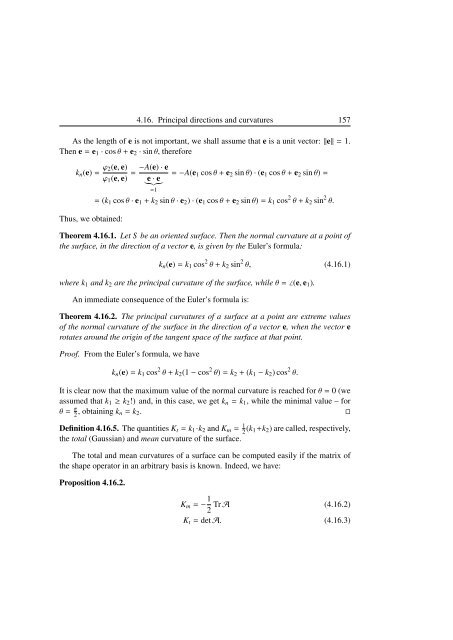Blaga P. Lectures on the differential geometry of - tiera.ru
Blaga P. Lectures on the differential geometry of - tiera.ru
Blaga P. Lectures on the differential geometry of - tiera.ru
You also want an ePaper? Increase the reach of your titles
YUMPU automatically turns print PDFs into web optimized ePapers that Google loves.
4.16. Principal directi<strong>on</strong>s and curvatures 157<br />
As <strong>the</strong> length <strong>of</strong> e is not important, we shall assume that e is a unit vector: �e� = 1.<br />
Then e = e1 · cos θ + e2 · sin θ, <strong>the</strong>refore<br />
kn(e) = ϕ2(e, e)<br />
ϕ1(e, e)<br />
Thus, we obtained:<br />
= −A(e) · e<br />
e · e<br />
����<br />
=1<br />
= −A(e1 cos θ + e2 sin θ) · (e1 cos θ + e2 sin θ) =<br />
= (k1 cos θ · e1 + k2 sin θ · e2) · (e1 cos θ + e2 sin θ) = k1 cos 2 θ + k2 sin 2 θ.<br />
Theorem 4.16.1. Let S be an oriented surface. Then <strong>the</strong> normal curvature at a point <strong>of</strong><br />
<strong>the</strong> surface, in <strong>the</strong> directi<strong>on</strong> <strong>of</strong> a vector e, is given by <strong>the</strong> Euler’s formula:<br />
kn(e) = k1 cos 2 θ + k2 sin 2 θ, (4.16.1)<br />
where k1 and k2 are <strong>the</strong> principal curvature <strong>of</strong> <strong>the</strong> surface, while θ = ∠(e, e1).<br />
An immediate c<strong>on</strong>sequence <strong>of</strong> <strong>the</strong> Euler’s formula is:<br />
Theorem 4.16.2. The principal curvatures <strong>of</strong> a surface at a point are extreme values<br />
<strong>of</strong> <strong>the</strong> normal curvature <strong>of</strong> <strong>the</strong> surface in <strong>the</strong> directi<strong>on</strong> <strong>of</strong> a vector e, when <strong>the</strong> vector e<br />
rotates around <strong>the</strong> origin <strong>of</strong> <strong>the</strong> tangent space <strong>of</strong> <strong>the</strong> surface at that point.<br />
Pro<strong>of</strong>. From <strong>the</strong> Euler’s formula, we have<br />
kn(e) = k1 cos 2 θ + k2(1 − cos 2 θ) = k2 + (k1 − k2) cos 2 θ.<br />
It is clear now that <strong>the</strong> maximum value <strong>of</strong> <strong>the</strong> normal curvature is reached for θ = 0 (we<br />
assumed that k1 ≥ k2!) and, in this case, we get kn = k1, while <strong>the</strong> minimal value – for<br />
θ = π<br />
2 , obtaining kn = k2. �<br />
Definiti<strong>on</strong> 4.16.5. The quantities Kt = k1·k2 and Km = 1<br />
2 (k1+k2) are called, respectively,<br />
<strong>the</strong> total (Gaussian) and mean curvature <strong>of</strong> <strong>the</strong> surface.<br />
The total and mean curvatures <strong>of</strong> a surface can be computed easily if <strong>the</strong> matrix <strong>of</strong><br />
<strong>the</strong> shape operator in an arbitrary basis is known. Indeed, we have:<br />
Propositi<strong>on</strong> 4.16.2.<br />
Km = − 1<br />
2 Tr A (4.16.2)<br />
Kt = det A. (4.16.3)












